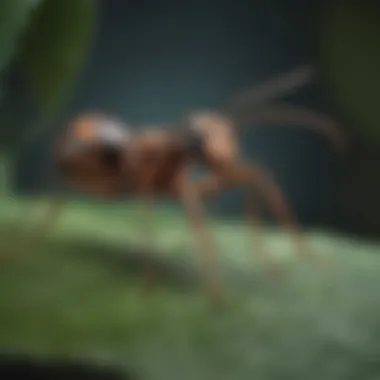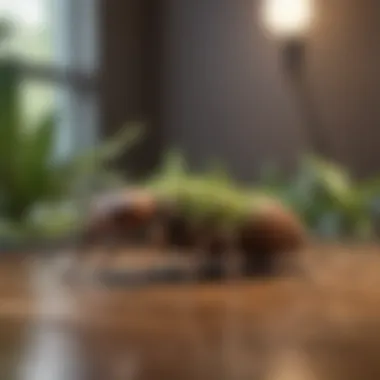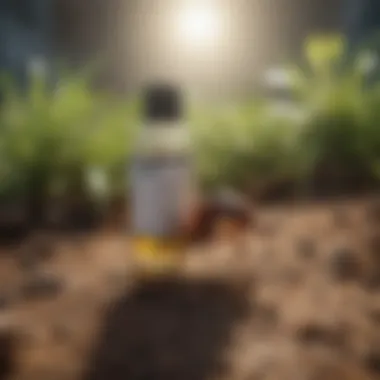Effective Strategies for Eradicating Big Ants


Intro
Ant infestations can be a significant nuisance for homeowners. However, understanding the reasons behind these invasions and implementing effective strategies allows for better management of larger ant species. Ants typically invade due to three primary factors: food sources, nesting sites, and environmental conditions conducive to their comfortable living. Knowing these elements helps in planning prevention and eradication.
This article delves deep into various methods to eradicate big ants, focusing on both prevention and eradication techniques. The following sections will cover behavioral insights, prevention tactics, as well as natural and chemical solutions. Homeowners can benefit from applying the best practices for maintaining a pest-free environment.
Informed decisions about pest control are essential, as they consider the specific characteristics of the ant species involved and tailor the approach accordingly.
Understanding the Ant Problem
The presence of big ants in living spaces can become more than just an annoyance. Understanding this issue is crucial for homeowners who wish to maintain comfortable and healthy environments. When one comprehends the nuances of ant behavior, it aids immensely in both prevention and eradication strategies. Knowledge of ant types, their habits, and reasons behind their invasions sets a foundation for effective action.
Types of Big Ants
Big ants come in various species, each with their unique characteristics and behaviors. The most common include:
- Carpenter Ants: Known for hollowing out wood for nests, posing risks to structural integrity.
- Pavement Ants: Often found nesting in concrete cracks, they may invade homes during foraging.
- Pestilent Ants: These aggressive ants can compromise hygiene and health due to their scavenging habits.
By identifying the species, one can tailor strategies for removal and prevention.
Ant Behavior and Nesting Habits
Ants are social insects that establish colonies. Understanding their nesting habits is essential. Most big ants prefer to build nests in hidden or sheltered locations. Common nesting sites include:
- Hollow trees or wooden structures for carpenter ants
- Under rocks, pavement, or debris for pavement ants
- Inside wall voids and insulation
Each species exhibits distinct foraging behaviors. For instance, carpenter ants tend to be more active at night, while others may forage during the day. Knowing when these ants are active can help in monitoring their activities and selecting effective intervention methods.
Reasons for Ant Invasions
Ant invasions usually occur due to several factors.
- Food Sources: Ants are attracted to easily accessible food. Leftover crumbs, spilled liquids, and pet food serve as major attractants.
- Moisture: Many species seek areas that provide ample moisture. Areas near water leaks or condensation can become hotspots for ant activity.
- Shelter: Cracks and crevices in the home provide ideal nesting sites. Maintenance of the home's structure plays a vital role in ant problems.
Understanding these factors highlights the importance of preemptive measures. Regular inspection and maintenance can drastically reduce the chances of ant invasions.
Prevention Techniques
In the context of eradicating big ants, prevention techniques play a crucial role. They are often the first line of defense against infestations. Effective prevention can significantly reduce the chances of these pests entering and establishing themselves in your living space. Understanding and implementing these techniques is beneficial not only for immediate ant issues but also for maintaining a longer-term solution against potential invasions.
Maintaining Clean Environments
A clean environment is essential in discouraging ants from invading your home. Ants are attracted to food scraps and spills. Regular cleaning practices like sweeping, vacuuming, and mopping can help eliminate food sources that attract these pests. Pay special attention to areas such as the kitchen and dining areas, where crumbs and spills are frequent.
It is also important to clean up pet food dishes after feeding time and not leave any food exposed overnight. The absence of food will significantly decrease the likelihood of ants coming inside. Moreover, removing clutter can reduce hiding places for ants and make it easier to spot any trails they might leave behind.
Sealing Entry Points
To further prevent ant invasions, sealing entry points around your home should be a priority. Ants are small but determined creatures. They can enter through very tiny gaps and cracks. Inspect your home for possible entry points and seal them using caulk or other appropriate materials. Key areas to check include windows, doors, and foundation gaps.
Additionally, ensure that screens on windows and doors are intact and free from tears. Adding door sweeps can also be an effective way to seal openings at the bottom of doors. By reducing potential entry points, you are making your home less accessible to these pests.
Proper Food Storage


Proper food storage is another vital technique in ant prevention. Ants are opportunistic feeders; they will readily invade if they detect food in any form. Store food in airtight containers made from glass or hard plastic. These containers prevent ants from accessing your food, while also helping to keep it fresh.
Additionally, be mindful of how you store non-food items. Items such as pet food should also be kept in airtight containers. Keep pantry areas organized, and regularly check for any expired products that might attract ants.
In managing your food storage effectively, you not only keep ants at bay but also improve your overall kitchen hygiene.
"An ounce of prevention is worth a pound of cure."
By employing these strategies, you can maintain a cleaner and safer environment, reducing the likelihood of big ants becoming a problem in your home.
Natural Remedies for Ant Elimination
Natural remedies for ant elimination play a significant role in addressing ant infestations, particularly for those who prefer non-toxic solutions. Many homeowners seek methods that minimize chemical exposure, both for health and environmental reasons. Natural remedies often utilize common household items that are economical and readily available. Understanding their efficacy, application, and limitations can empower homeowners to tackle issues with big ants effectively.
Vinegar Solutions
Vinegar serves not only as a culinary ingredient but also as a powerful tool in ant control. Its pungent smell acts as a deterrent to ants, disrupting their scent trails, which they rely on for navigation. To create an effective vinegar solution, mix equal parts of water and white vinegar in a spray bottle. This mixture can be sprayed directly on ant trails and around entry points to deter further invasions.
In addition to acting as a repellent, vinegar is safe for the environment and poses minimal risk to children and pets when used in moderation. However, it may be less effective in severe infestations, which could require combining vinegar with other strategies for better results.
Essential Oils
Essential oils, derived from plants, are another natural method for managing ant problems. Oils like peppermint, tea tree, and citrus have been noted for their insect-repelling properties. Due to their strong scent, these oils confuse and repel ants, making it difficult for them to find their way back to their nests. To use essential oils, dilute a few drops with water in a spray bottle and apply to suspected nesting areas and along known ant trails.
Using essential oils has the added benefit of pleasant aromas compared to harsher chemical alternatives. However, it is important to note that, like vinegar, they may not eliminate established colonies and are best used as part of a broader strategy.
Boric Acid Mixtures
Boric acid is a naturally occurring compound that has gained recognition for its effectiveness against ant infestations. When mixed with sugar and water, it becomes an attractive bait for ants. The sugar lures the ants, while the boric acid disrupts their digestive systems upon ingestion. A common recipe involves mixing one part boric acid, three parts sugar, and two parts water until dissolved. This solution can be placed in small containers near ant trails, but care should be taken to place them out of reach of pets and children.
Boric acid mixtures are particularly effective in targeting the queen and the colony, potentially leading to long-term eradication. Yet, patience is needed as this method may take time to show results.
While natural remedies can be effective in managing ant problems, severe infestations or a lack of results may require consideration of additional strategies, including chemical solutions.
Chemical Solutions for Ant Control
Chemical solutions play a crucial role in the management of large ant species. They can provide rapid results when other methods may fall short. Homeowners often encounter situations where natural remedies are not enough, especially in cases of significant infestations. Understanding the various chemical options available can enhance your ability to effectively combat these pests.
Using chemical solutions includes several approaches, each with unique benefits and considerations. While some products specifically target ant behavior and physiology, selecting the right solution depends on various factors like the ant species, the extent of the infestation, and safety concerns for humans and pets.
Incorporating these solutions into your eradication strategy often requires a thoughtful assessment of how they interact with environmental factors and existing pest control measures. Here’s a closer look at specific types of chemical solutions:
Types of Ant Baits
Ant baits are among the most effective tools for managing ant populations. They usually contain a slow-acting poison mixed with an attractive bait that lures ants in. This allows for a toxic effect not only on the individual ant but also on the colony when they return to feed others. Commonly used baits include products containing hydramethylnon, fipronil, and boric acid.
Key Advantages of Ant Baits:
- Highly effective as they can eliminate the entire colony by targeting the queen.
- Easy to use and place strategically around the home.
- Minimized risk of direct exposure for children and pets since the bait is contained.
When selecting ant baits, consider the specific species you are targeting. For example, some ants prefer protein-based baits while others are more attracted to sweets. Matching the bait to the ant's dietary preferences increases effectiveness.
Sprays and Insecticides
Sprays and insecticides offer a direct approach to eliminate ants, especially in visible trails or nests. These products can kill ants on contact, which is important for immediate relief from an infestation. Common formulations include permethrin, bifenthrin, and lambda-cyhalothrin.


Considerations for Using Sprays:
- Immediate results can be achieved against visible infestations.
- Some products create a barrier that prevents future ant activity in treated areas.
- Safety instructions must be followed closely to avoid harmful exposure.
While sprays are effective for quick elimination, they might not reach all ants, especially those deep in nests. Therefore, this method is often used in conjunction with baiting strategies for comprehensive management.
Professional Pest Control Services
When faced with a persistent ant problem, seeking the help of professional pest control services can be a wise choice. These experts have access to more potent chemical solutions and can tailor their approach based on thorough assessments of your home’s conditions and specific ant species.
Benefits of Hiring Professionals:
- Advanced knowledge leads to an effective and targeted treatment plan.
- They often provide long-term strategies and regular monitoring.
- Reduction in health risks due to professional handling of chemicals.
Professional pest control combines experience and education in pest behavior, ensuring that not just the visible ants are treated, but also the root causes of the infestation.
"Chemical solutions should be part of an integrated pest management strategy that includes prevention and monitoring."
Monitoring and Assessment
Effective monitoring and assessment are crucial steps in managing big ant infestations. This process allows homeowners to understand the extent of an ant problem and to formulate targeted strategies for eradication. By monitoring ant activity, one can not only identify the presence of ants but also determine their nesting locations and behavior patterns. This knowledge is integral for preventing future invasions, as it helps in pinpointing areas that need more attention.
Benefits of monitoring include early detection, which can mitigate the risk of a large-scale infestation. Identifying ant trails leads to a better understanding of how ants navigate their environments. Furthermore, by assessing nest locations, homeowners can decide whether to use natural or chemical methods for control, making their efforts more efficient. Adjusting control strategies based on continuous assessment helps to adapt to the evolving behavior of ant populations.
Identifying Ant Trails
Identifying ant trails is a foundational aspect of monitoring. Ants often follow specific paths to transport food and other resources. These trails are usually visible as lines of ants moving to and from their nest and food sources. Homeowners can often observe these trails in areas where ants are active, such as kitchens or near waste bins. To effectively identify trails, one should look closely at the ground and surrounding surfaces. Additionally, paw prints and pheromones left by the ants play important roles in their trail patterns.
- Observation Tips:
- Check for long lines of ants during peak activity times, usually in the morning or evening.
- Look for trails leading to food sources or dump sites.
- Use a flashlight to spot trails, especially in dim lighting.
Keeping a log of ant sightings can help in identifying the most problematic areas.
Evaluating Nest Locations
Evaluating nest locations is the next critical step in monitoring. Nests can be found both indoors and outdoors, sometimes in hidden spaces like wall voids, under flooring, or in soil. Common signs of nests include increased ant activity in certain areas and visible constructions such as dirt mounds or small openings. To locate nests, pay attention to where ants are most frequently observed.
- Methods to Locate Nests:
- Follow ant trails backwards to find the source.
- Inspect areas around potential nesting sites like potted plants, wood piles, or refrigerator coils.
- Listen for sounds; some large ants may produce faint noises when disturbing nests.
By understanding where ants are coming from, one can better plan for elimination strategies. Long-term management can then be established, significantly reducing the likelihood of future invasions. This ongoing assessment is key to a successful ant management strategy and ultimately contributes to a more comfortable living space.
Long-term Strategies for Ant Management
Long-term strategies for ant management are essential in maintaining a pest-free environment. Once an ant invasion has been controlled, it is vital to implement sustained measures to prevent future infestations. This section emphasizes various elements that contribute to effective long-term management, the benefits they bring, and considerations homeowners should keep in mind.
The need for ongoing ant management cannot be overstated. Ants, particularly larger species, can quickly return if conditions remain favorable for them. Implementing effective long-term strategies creates a robust defense against these pests. Such strategies not only eliminate existing ant colonies but also deter new ones from establishing in the future.
Environmental Modifications
Making changes to the environment is one of the most effective long-term strategies for preventing ant invasions. This involves a careful assessment of outdoor and indoor spaces. Here are some modifications to consider:


- Landscape Management: Trim bushes and trees that touch the structure of your home. Limiting vegetation can help reduce access points for ants.
- Drainage and Moisture Control: Ensure that water does not pool in areas close to the foundation. Proper drainage reduces moisture, which attracts ants searching for water.
- Food Source Reduction: Be mindful of feeding pets outdoors. Uneaten food can lure ants.
Implementing these modifications creates an environment less conducive to ant infestations. It also promotes a healthier living space.
Using Barriers and Repellents
Using barriers and repellents is a proactive approach in the long-term management of ants. These measures provide an added line of defense against potential intrusions. Here are key points to consider:
- Physical Barriers: Seal gaps around windows, doors, and the foundation with caulk. This discourages ants from finding entry points into the home.
- Natural Repellents: Essential oils such as peppermint or tea tree oil can be applied around entry points. Their strong scents can deter ants effectively.
- Chemical Barriers: Pesticide barriers may be used around the perimeter of your home. These should be selected carefully to ensure they are safe for the environment and not harmful to humans or pets.
In summary, combining environmental modifications with barriers and repellents creates a comprehensive strategy for long-term ant management. These practices lead to an effective reduction in the likelihood of ant invasions while fostering an overall healthier habitat.
"Successful ant management is not merely about immediate eradication; it is about creating sustainable living conditions that deter their presence for the long haul."
Adopting these strategies will equip homeowners with the tools necessary to maintain control over ant populations, ensuring that their living spaces remain pleasant and pest-free.
Impact of Ants on Living Spaces
The presence of big ants can significantly disrupt living spaces. Understanding the impact ants have is crucial for homeowners who seek to maintain a comfortable and hygienic environment. This section discusses structural damage considerations and health risks associated with ants. Both elements are fundamental to comprehending why effective eradication strategies are necessary.
Structural Damage Considerations
Big ants, such as carpenter ants, can cause notable structural damage. Unlike other ant species that may invade homes to search for food, carpenter ants make their nests in wood. This behavior leads to an increased risk of property damage over time. Carpenter ants excavate wood to create galleries for their nests, which can weaken the integrity of wooden structures. Homeowners may not immediately notice the damage, but it can become severe without intervention.
To prevent structural damage, it is vital to identify signs of a carpenter ant infestation. These signs include small piles of sawdust, which indicate wood shredding, and the presence of winged ants during warmer months, often signaling a colony's reproductive phase. Regular inspections of wooden areas in and around the home can help detect these issues early.
"Ignoring the presence of large ants in your home can lead to severe consequences and costly repairs."
Maintaining proper ventilation and moisture control can also reduce the likelihood of infestations. Carpenter ants are more attracted to damp environments. Sealing gaps in siding, roofs, and foundations helps prevent their entry and nesting. By taking these precautions, homeowners can safeguard their properties against structural risks posed by big ants.
Health Risks Associated with Ants
Ants often go unnoticed, yet they pose various health risks, especially in homes with food supplies. While many ant species, including larger ones, mainly seek out sugary or fatty foods, their foraging can lead to contamination. Ants can carry bacteria and pathogens on their bodies, transferring them to kitchen countertops, food items, and utensils when they invade.
Additionally, certain ant species can trigger allergic reactions in sensitive individuals. The bites or stings from some larger ants, like fire ants, can cause severe discomfort. Their venom can induce anaphylactic reactions in vulnerable people, leading to serious health complications. Therefore, it is essential to control ant populations proactively to create a safer living environment.
To mitigate health risks:
- Store food in airtight containers.
- Maintain cleanliness by promptly cleaning up food spills.
- Seal any cracks or gaps around your home to reduce potential entries.
By recognizing the potential health hazards posed by big ants, homeowners can implement appropriate strategies, thereby ensuring the safety of their living spaces.
Finale
The conclusion serves as a critical component in understanding how to effectively manage and eradicate big ants. This section synthesizes the various methods discussed throughout the article, highlighting their importance and relevance. As we reflect on the overall strategies presented, it is vital to recognize the multifaceted approach necessary for ant control. The strategies encompass prevention, monitoring, and both natural and chemical eradication methods, which, when implemented correctly, empower homeowners to maintain their living spaces.
Summary of Effective Methods
Here are some key takeaways regarding effective methods:
- Preventive Techniques: Keeping environments clean and securing food sources are your first line of defense. Regular cleaning routines and storing food in airtight containers can deter ant invasions.
- Natural Remedies: Solutions like vinegar, essential oils, and boric acid mixtures often provide an eco-friendly way to combat ant problems without chemical exposure.
- Chemical Solutions: When natural methods fall short, utilizing targeted ant baits and insecticide sprays can efficiently eliminate larger infestations.
- Monitoring: Identifying trails and nest locations is crucial for understanding ant behavior and planning an effective eradication strategy.
- Long-term Management: Environmental modifications and barriers can help ensure sustained control over time, preventing future invasions.
"Balanced methods combining prevention, natural, and chemical solutions yield the best results in effectively managing big ant populations."
Future Considerations for Homeowners
Looking ahead, homeowners ought to be proactive in their ant management strategies. Consider the following:
- Regular Inspections: Frequently check for new trails or nests around your property. Early detection leads to quicker action and solutions.
- Education: Understanding ant behavior and species can help homeowners select the most effective strategies tailored to their specific situation. Researching types like fire ants or carpenter ants is essential.
- Sustainable Practices: Opting for environment-friendly methods aligns with growing concerns about ecological impact. Making informed choices can lead to minimal disruption of local ecosystems while also managing ant populations.
- Professional Consultation: Engaging pest control professionals for advice can be beneficial, particularly in cases of severe infestations. They may offer insights into advanced strategies suitable for unique scenarios.
By keeping these considerations in mind, homeowners can cultivate a resilient approach to ant control, preserving the sanctity of their living spaces while warding off future infestations.















